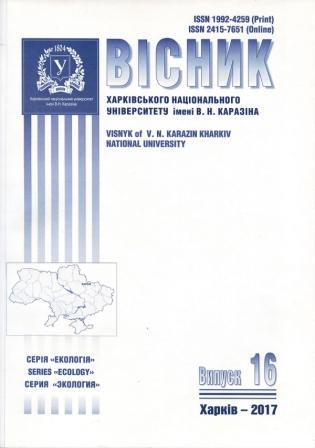Noise Load at Urbolandscapes of Pervomaysky, as the Nature Use Conflict
Abstract
The peculiarity of landscape-ecological planning (LEP) of urban landscapes is the need to carry out an ecological survey of the territory with the widest possible range of indicators, which increases the objectivity of identifying environmental management conflicts. One of the sources of conflicts in urbollandscapes is noise, the intensity of which varies both during the day and during the week. Purpose of the study is a spatio-temporal estimation of the noise load on the urbolandscape in the Pervomaisky, Kharkov region. Methods. The noise was measured using a Digital Sound Level Meter with spatial reference to GPS coordinates. Results. The total volume of the array of experimental data obtained is 1440, based on the statistical processing of which cartographic models of the spatial distribution of the noise load within the city for four periods (working day and day, morning and noon) were developed. It is established that the noise level within the linear-road landscapes is 65-70 dB, in the residential - 48-55 dB; Protective-recreational and garden-park - 36-44 dB. The maximum noise level is fixed in the joint impact area of industrial and linear-road landscapes - 85 dB, that is the main source of noise in the city of Pervomaisky is transport. Conclusions. The obtained results provide the basis for the next stage of the transmission line - the development of directions for improving the ecological state of linear-road and adjacent landscapes.
Downloads
References
Максименко Н. В., Клєщ А. А. Ландшафтно-екологічне планування, як інструмент для покращення екологічного стану міст//Екологічний стан і здоров`я жителів міських екосистем. Горбуновські читання: тези доповідей / за ред. Масікевича Ю. Г. – Чернівці «Місто», 2015. С. 90-91.
Максименко Н. В., Клєщ А. А. Методичні особливості інвентаризаційного етапу ландшафтно-екологічного планування // Охорона довкілля: зб. наук. статей ХІ Всеукраїнських наукових Таліївських читань. Х.: ХНУ ім. В. Н. Каразіна, 2015. С. 35–38.
Максименко Н. В., Клєщ А. А., Михайлова К. Ю., Гоголь О. М. Особливості ландшафтно-екологічного планування територій різного функціонального призначення // Географія, екологія, туризм: теорія, методологія, практика: Матеріали міжнародної науково-практичної конференції, присвяченої 25-річчю географічного факультету Тернопільського національного педагогічного університету імені В. Гнатюка 21-23 травня 2015, Тернопіль : СМП «Тайп», 2015. С.249-251.
СНиП 11-12-77. Нормы проектирования. Защита от шума. Москва: Госстрой СССР, 1977.
Максименко Н. В., Владимирова О. Г., Шевченко А. Ю., Кочанов Е. О. Нормування антропогенного навантаження на навколишнє природне середовище // Підручник для студентів екологічних спеціальностей вищих навчальних закладів, Харків, ХНУ імені В. Н. Каразіна, 2015. 256 с.
Шумомеры. Общие технические требования и методы испытаний: ГОСТ 17187-81. (СТ СЭВ 1351-78), Москва: Государственный Стандарт, 1982.
Максименко Н.В., Медведєва Ю. В. Оцінка шумового забруднення Московського проспекту // Охорона довкілля. Збірник наукових праць VІІ Всеукраїнських наукових Таліївських читань. Харків, 2011. С. 79-83.
Максименко Н.В. Ландшафтно-экологическое планирование территорий для нужд государственного регулирования природопользования в Украине // Научно-методические и прикладные аспекты экологизации: Монография под общ. ред. И. Ю. Швец. – Симферополь : ДИАЙПИ, 2013. С.274-291.
Authors who publish with this journal agree to the following terms:
- Authors retain copyright and grant the journal right of first publication of this work under the terms of a license Creative Commons Attribution License 4.0 International (CC BY 4.0).
- Authors are able to enter into separate, additional contractual arrangements for the non-exclusive distribution of the journal's published version of the work (e.g., post it to an institutional repository or publish it in a book), with an acknowledgement of its initial publication in this journal.
- Authors are permitted and encouraged to post their work online (e.g., in institutional repositories or on their website) prior to and during the submission process, as it can lead to productive exchanges, as well as earlier and greater citation of published work.





